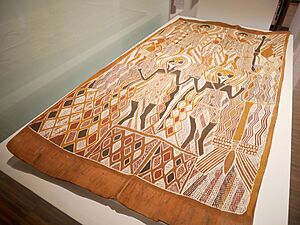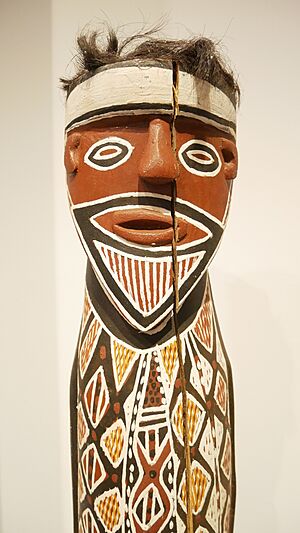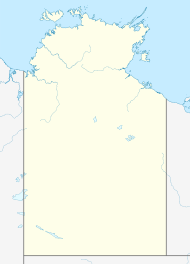Yirrkala facts for kids
Quick facts for kids YirrkalaNorthern Territory |
|
|---|---|
| Postcode(s) | 0880 |
| Elevation | 8 m (26 ft) |
| Location | |
| LGA(s) | East Arnhem Region |
| Territory electorate(s) | Mulka |
| Federal Division(s) | Lingiari |

Yirrkala is a small community in the East Arnhem Region of the Northern Territory, Australia. It is about 18 kilometers (11 miles) southeast of the mining town of Nhulunbuy. Yirrkala is located on the Gove Peninsula in Arnhem Land.
Most people living in Yirrkala are Aboriginal Australians from the Yolngu people. Some pilots and engineers from Mission Aviation Fellowship also live here. They help provide air transport services in Arnhem Land. In 2021 census, Yirrkala had 657 residents. About 80% of them identified as Aboriginal and/or Torres Strait Islander people.
Contents
Yirrkala's History
The Mission Years
An Aboriginal community has always been in Yirrkala. The community grew much larger when the Yirrkala mission started in 1935. People from 13 different Yolngu clans moved to Yirrkala then. Around this time, the Methodist Overseas Mission (MOM) encouraged its leaders to study anthropology. This helped them learn about Aboriginal Australian culture, especially the Yolngu people.
Early mission leaders included Wilbur Chaseling and Edgar Wells. They wrote about their time there. People could come and go freely. The Yolngu people welcomed Christianity into their own beliefs.
The MOM mission received money from the government. School classes began in 1936. At first, they were held outside under a tree. Later, a new school building was built in 1951. By 1952, 47 children regularly attended classes.
During World War II, an RAAF airbase was nearby. Many mission residents worked there. They were boat pilots for the RAAF and Royal Australia Navy. They also helped the war effort in other ways. The school closed during this time. All "white women" were moved away in 1942.
Around 1974, the Yirrkala Dhanbul Community Association took over the mission. It stopped being run as a mission after that.
Land Rights and the Bark Petition
Yirrkala played a big part in the relationship between Indigenous and non-Indigenous Australians. In 1963, the Bark Petition was created in Yirrkala. It was sent to the Federal Government. This was to protest the Prime Minister's plan to sell their land. The land was to be used by a bauxite mining company.
The petition did not stop the bauxite mining at Nhulunbuy. However, it made other Australians realize that Indigenous people needed a say. It led to a government report. This report suggested payments and protecting sacred sites. It also said Indigenous people had a moral right to their lands. The original Bark Petition is now on display at Parliament House in Canberra.
Community and Governance
Yirrkala is a small community in the East Arnhem Region, Northern Territory. It is 18 kilometers (11 miles) southeast of the mining town of Nhulunbuy. It sits on the Gove Peninsula in Arnhem Land.
As of 2026, the East Arnhem Regional Council is the local government for Yirrkala. It works with the Yirrkala Mala Leaders Association. This group has 12 elected community members.
The Northern Land Council is also important. It is responsible for land matters under the Aboriginal Land Rights (Northern Territory) Act 1976.
Culture and Art

Yirrkala is home to many famous Indigenous artists. Their traditional Aboriginal art, especially bark painting, is shown in galleries worldwide. Their work often wins awards. You can see their art at the Buku-Larrnggay Mulka Art Centre and Museum.
Yirrkala is also a traditional home of the Yidaki (didgeridoo). Some of the best didgeridoos in the world are still made here.
Buku-Larrnggay Mulka Centre
The Buku-Larrnggay Mulka Centre is a famous art center. Well-known artists like Nyapanyapa Yunupingu work there. People often call it "Buku" for short.
The center has a stage called the Roy Marika Stage. It is used for the yearly Yarrapay Festival. The festival in June 2021 featured bands like the Andrew Gurruwiwi Band and Yothu Yindi.
Local artists started the center in 1976. It was in the old Mission health center. This happened as the Aboriginal land rights movement grew.
The historic Yirrkala Church Panels were made in 1963. Yolngu elders painted these large sheets. They showed their ancestral stories and clan designs. The church threw them away in 1974. But Buku-Larrnggay saved them in 1978.
As of 2015[update], the center worked with over 300 artists. Their art was shown across Australia and around the world. As of 2020[update], the center has two parts. The Yirrkala Art Centre sells contemporary art. The Mulka Project includes the museum. The center is known for its bark paintings, weaving, and larrakitj (memorial poles).
Many major artists have worked at the center. These include Gulumbu Yunupingu and Banduk Marika. Many women artists have also worked there. Five sisters from the Yunupingu family are among them.
Education in Yirrkala
Yirrkala School is now called "Yirrkala Community Education Centre" (Yirrkala CEC). Students here learn using a "both ways" method. This means they have bilingual studies. They also learn a cultural curriculum called Galtha Rom, which means cultural lessons.
In 2009, the Northern Territory Government ordered schools to teach English first. But Yirrkala School kept teaching in its own way. The child's first language, Yolngu Matha, was taught alongside English. This method has helped reduce students dropping out. In 2020, eight students were the first to graduate year 12. They got scores good enough to go to university. Yirrkala School is now a model for learning in remote communities.
Yalmay Marika Yunupingu
Artist and teacher Yalmay Marika Yunupingu was born around 1955. She is part of the famous Marika family. She is the daughter of artist Mathaman Marika. She was married to Yothu Yindi lead singer and educator Dr M Yunupingu.
She has translated children's books into Yolngu Matha languages. She taught "both ways" bilingual education her whole career. She stood strong against policies that said schools should only teach in English. This was even though Yirrkala School was known for its bilingual program.
Yunupingu became a senior teacher in 2004. She was often called "mother of the school." She helped mentor other teachers. She won an award for Teaching Excellence in the Remote Primary category. Her artwork has been shown in Australia and the US.
She retired in early 2023 after 40 years at the school. Family, friends, and colleagues celebrated her work. Since retiring, she teaches traditional healing with bush medicines.
On January 25, 2024, she was named 2024 Senior Australian of the Year. She traveled to Canberra to accept the award.
Heritage Sites
Yirrkala has some important heritage sites. These include the Wurrwurrwuy stone arrangements.
Notable People from Yirrkala
- Timmy 'Djawa' Burarrwanga – a businessman and cultural leader.
- Raphael Clarke (born 1985) – an Australian rules footballer.
- Nathan Djerrkura (born 1988) – an Australian rules footballer.
- Nonggirrnga Marawili (born around 1938) – a painter.
- Banduk Marika (1954–2021) – an artist.
- Yirrmal Marika (born 1993) – an Australian singer.
- Maminydjama Maymuru (born 1997) – a model.
- Kwame Yeboah (born 1994) – a professional football player.
- Yothu Yindi (1986–2000) – a famous rock band.
- Galarrwuy Yunupingu (1948–2023) – a land rights activist.
- Mandawuy Yunupingu (1956–2013) – a musician and educator.
- Nyapanyapa Yunupingu (born around 1945) – a painter.




